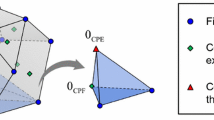Abstract
This paper presents a novel three-dimensional hybrid smoothed finite element method (H-SFEM) for solid mechanics problems. In 3D H-SFEM, the strain field is assumed to be the weighted average between compatible strains from the finite element method (FEM) and smoothed strains from the node-based smoothed FEM with a parameter α equipped into H-SFEM. By adjusting α, the upper and lower bound solutions in the strain energy norm and eigenfrequencies can always be obtained. The optimized α value in 3D H-SFEM using a tetrahedron mesh possesses a close-to-exact stiffness of the continuous system, and produces ultra-accurate solutions in terms of displacement, strain energy and eigenfrequencies in the linear and nonlinear problems. The novel domain-based selective scheme is proposed leading to a combined selective H-SFEM model that is immune from volumetric locking and hence works well for nearly incompressible materials. The proposed 3D H-SFEM is an innovative and unique numerical method with its distinct features, which has great potential in the successful application for solid mechanics problems.
Similar content being viewed by others
References
LeVeque R.J.: Finite Volume Methods for Hyperbolic Problems. Cambridge University Press, New York (2002)
Li R.H., Chen Z.Y., Wu W.: Generalized Difference Methods for Differential Equations: Numerical Analysis of Finite Volume Methods. Marcel Dekker, New York (2000)
Wu T.W.: Boundary Element in Acoustics: Fundamentals and Computer Codes. WIT Press, Southampton (2000)
Liu Y.J.: Fast Multipole Boundary Element Method: Theory and Applications in Engineering. Cambridge University Press, Cambridge (2009)
Zienkiewicz O.C., Taylor R.L.: The Finite Element Method, 5th edn. Butterworth-Heinemann, Oxford (2000)
Liu G.R., Quek S.S.: Finite Element Method: A Practical Course. Butterworth-Heinemann, Burlington (2003)
Liu G.R., Liu M.B.: Smoothed Particle Hydrodynamics: A Meshfree Practical Method. World Scientific, Singapore (2003)
Belytschko T., Lu Y.Y., Gu L.: Element-free Galerkin methods. Int. J. Numer. Methods Eng. 37, 229–256 (1994)
Liu G.R.: Meshfree Methods: Moving Beyond the Finite Element Method, 2nd edn. CRC Press, Boca Raton (2009)
Arnold D.N.: Mixed finite element methods for elliptic problems. Comput. Methods Appl. Mech. Eng. 82, 281–300 (1990)
Brezzi F., Fortin M.: Mixed and Hybrid Finite Element Methods. Springer, New York (1991)
Liu G.R., Dai K.Y., Nguyen T.T.: A smoothed finite element method for mechanics problems. Comput. Mech. 39, 859–877 (2007)
Liu G.R., Nguyen T.T., Dai K.Y. et al.: Theoretical aspects of the smoothed finite element method (SFEM). Int. J. Numer. Methods Eng. 71, 902–930 (2007)
Malkus D.S., Hughes T.J.R.: Mixed finite element methods—reduced and selective integration techniques: a unification of concepts. Comput. Methods Appl. Mech. Eng. 15, 63–81 (1978)
Pian T.H.H., Sumihara K.: Rational approach for assumed stress finite elements. Int. J. Numer. Methods Eng. 20, 1685–1695 (1984)
Reese S., Wriggers P.: A stabilization technique to avoid hourglassing in finite elasticity. Int. J. Numer. Methods Eng. 48, 79–109 (2000)
Rong T.Y., Lu A.Q.: Generalized mixed variational principles and solutions for ill-conditioned problems in computational mechanics—part I: volumetric locking. Comput. Meth. Appl. Mech. Eng. 191, 407–422 (2001)
Liu G.R., Gu Y.T.: An Introduction to Meshfree Methods and Their Programming. Springer, Dordrecht (2005)
Chen J.S., Wu C.T., Yoon S. et al.: A stabilized conforming nodal integration for Galerkin mesh-free methods. Int. J. Numer. Methods Eng. 50, 435–466 (2001)
Liu G.R., Nguyen T.T., Lam K.Y.: Novel alpha finite element method (αFEM) for exact solution to mechanics problems using triangular and tetrahedral elements. Comput. Meth. Appl. Mech. Eng. 197, 3883–3897 (2008)
Zhang G.Y., Liu G.R., Wang Y.Y. et al.: A linearly conforming point interpolation method (LC-PIM) for three-dimensional elasticity problems. Int. J. Numer. Methods Eng. 72(113), 1524–1543 (2007)
Liu G.R., Nguyen T.T., Nguyen H.X. et al.: A node-based smoothed finite element method (NS-FEM) for upper bound solutions to solid mechanics problems. Comput. Struct. 87, 14–26 (2009)
Liu G.R., Zhang G.Y.: Upper bound solution to elasticity problems: a unique property of the linearly conforming point interpolation method (LC-PIM). Int. J. Numer. Methods Eng. 74, 1128–1161 (2008)
Liu G.R., Nguyen T.T., Lam K.Y.: An edge-based smoothed finite element method (ES-FEM) for static and dynamic problems of solid mechanics. J. Sound Vib. 320, 1100–1130 (2009)
He Z.C., Li G.Y., Zhong Z.H. et al.: An edge-based smoothed tetrahedron finite element method (ES-T-FEM) for 3D static and dynamic problems. Comput. Mech. 52, 221–236 (2013)
Liu G.R.: A generalized gradient smoothing technique and the smoothed bilinear form for Galerkin formulation of a wide class of computational methods. Int. J. Comput. Methods. 5, 199–236 (2008)
Liu G.R.: A weakened weak (W2) form for a unified formulation of compatible and incompatible methods, Part I: Theory and Part II: Applications to solid mechanics problems. Int. J. Numer. Methods Eng. 81, 1093–1156 (2010)
Xu X., Gu Y.T., Liu G.R.: A hybrid smoothed finite element method (H-SFEM) to solid mechanics problems. Int. J. Comput. Methods. 10, 1–17 (2013)
Bathe K.J.: Finite Element Procedures. MIT Press, Prentice-Hall: Cambridge (1996)
Reddy J.N.: An Introduction to Nonlinear Finite Element Analysis. Oxford University Press, Oxford (2004)
Timoshenko S.P., Goodier J.N.: Theory of Elasticity, 3rd edn. McGraw-Hill, New York (1970)
Hughes T.J.R.: The Finite Element Method: Linear Static and Dynamic Finite Element Analysis. Prentice-Hall, Englewood Cliffs (1987)
Author information
Authors and Affiliations
Corresponding author
Rights and permissions
About this article
Cite this article
Li, E., He, Z.C., Xu, X. et al. A three-dimensional hybrid smoothed finite element method (H-SFEM) for nonlinear solid mechanics problems. Acta Mech 226, 4223–4245 (2015). https://doi.org/10.1007/s00707-015-1456-6
Received:
Revised:
Published:
Issue Date:
DOI: https://doi.org/10.1007/s00707-015-1456-6




